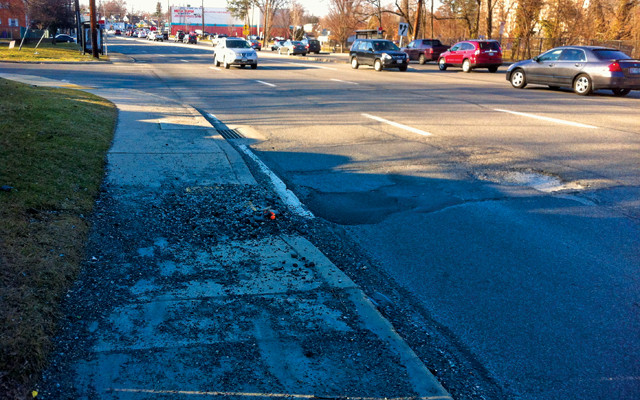
by Edward R. Landa Tuesday, September 22, 2015

A pothole and "ejecta" debris near the author's house in Silver Spring, Md. Credit: Edward R. Landa.
Last winter was truly severe in the northeastern U.S. Snowfall records were blown away in cities like Boston, which finally saw its last snow pile melt away in mid-July. Even though last season’s snow is gone, residents spent months dealing with the recovery — especially in the form of fixing roads left with gaping roadway potholes. Hard-hit Massachusetts established a “Winter Recovery Assistance Program,” providing $30 million to help cities and towns fill potholes. But until they were filled, in Massachusetts and elsewhere, drivers had to endure seemingly endless bone-jarring shocks as their car tires dropped into the enormous and abundant potholes. Bumpily driving along one day last spring left me pondering potholes — from a geologic perspective.
I have to confess to an atypical fascination with roadways. My research has included studies of tire-wear particles as an environmental source of zinc, and my eyes are now forever attuned to spotting tire chunks and “road gators”— large sections of tire tread from trucks and buses. I have even repurposed some of the latter, for example, making a road-gator chair. Other forms of vehicle-related contaminants out there on the roadways include materials such as brake-wear dust (containing copper), lost wheel weights (containing lead) and highway-marking paint (containing chromium). But I hadn’t, until recently, stopped to think about potholes — and more specifically, the material ejected out of the potholes.
One question that came to mind was, “Where is the material that once filled these holes?” A quick glance at a nearby sidewalk answered that question; the sidewalks and shoulders were covered with an out-of-place blanket of broken asphalt and gravel. It reminded me, a soil scientist, of the disruption of soil aggregates that we see in time-lapse photography of a single raindrop crashing onto bare ground and ejecting soil particles as far away as one meter.
Indeed, the mechanics of raindrop splash on soil has some parallels to the pothole case. Potholes start forming when the weather turns colder. Snowmelt or rain seeps into the soil and roadway sub-base below the pavement. When temperatures drop, that moisture freezes, causing the ground to expand, which pushes the pavement upward and forms a little raised area, like a pimple on the face of the road. As temperatures later rise, the pavement pimple shrinks, but not all the way to flat. Instead, a gap remains between the pavement and the layers below. As a heavy vehicle drives over this slightly domed cavity, the pavement cracks and falls into the hole below. As another vehicle drives over the new hole, it violently ejects the cracked asphalt out of the hole. And thus a pothole is born. By analogy, in the case of raindrop impact on soil, we get the ejection of soil particles formed by prior weathering activity, including the action of freezing and thawing. And just what is this roadside deposit of broken chunks of pavement called? A planetary geologist might call this expelled debris “ejecta,” although as a soil scientist, “ejecta” is not a part of my everyday lexicon. In some ways the material does resemble what’s strewn about by meteorite impacts. However, as opposed to an impact, which both fragments and then ejects crustal material, the impact of a car tire on ice-damaged pavement ejects pieces of pavement that have already been fragmented by freeze-thaw forces. Without a unanimous and/or scientifically accepted term to go on, I’ve wondered how others describe this pothole-derived material.
In fact, a quick Internet search turns up multiple uses of ejecta to describe pothole refuse. Such usage is common within a select community: British bicyclists. This bicyclist’s report in February 2013 on a street not far from Wembley Stadium in London is a case in point: “Largish circular pothole on leading edge of speed bump … There is considerable ejecta on the road and adjacent pavement. This has been there at least two weeks, but is often covered by parked vehicles, although the ejecta on the pavement should help locate it.” The term is also widely used among American military engineers in describing bomb-cratered terrains that can be covered with ejecta. It’s not a description of a pothole, per se, but close enough.
So, it seems the public at least has already spoken. Ejecta: headed to your neighborhood roads and sidewalks this winter. Ejecta: not just for planetary geologists anymore.
© 2008-2021. All rights reserved. Any copying, redistribution or retransmission of any of the contents of this service without the expressed written permission of the American Geosciences Institute is expressly prohibited. Click here for all copyright requests.